#altocumulus cloud cover
Text
Sailor's weather superstition
Of course superstition doesn't stop here either and to be clear it's only a thing with sailors but also with farmers and so on.
But here are a few:
A ring around the sun or moon, means that rain will come real soon
If you see a halo around the moon on a clear night, it could be an indication of bad weather. This is not a spooky prediction, but quite banal science. Although it looks like a ghostly ring, it is really just the light of the moon refracted (or bent) by ice crystals. These ice crystals form the cirrus clouds - the tuft-like clouds we find high up in the sky. These cirrus clouds don't cause rain or storms, but here's the thing: they precede some low pressure areas by a day or two, and low pressure areas bring precipitation.
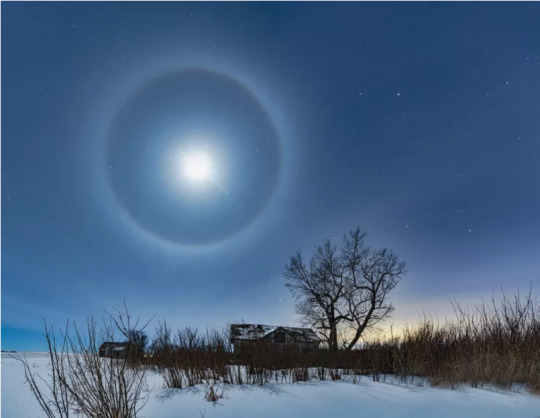
(x)
In other words: If you see these ice clouds refracting the light around the moon, it means that cirrus clouds are present, which could indicate a coming storm. also goes with the sun, but please don't look in there, it's not good for your eyes.
Mackerel sky, not 24 hours dry
A mackerel sky looks like a sky full of fish scales. These are cirrocumulus or altocumulus clouds formed by atmospheric waves at high altitudes. As these high clouds gradually penetrate the sky and the air pressure begins to drop, precipitation associated with the disturbance can be expected in about 6 to 12 hours.

(x)
A thickening and lowering of cirrocumulus to altostratus or altocumulus in the middle tier is a good sign that the warm or low pressure front has moved closer and rain may begin to fall within less than six hours.
Clear moon, frost soon
Well, that's what they say about clear nights in winter, clear moon, frost soon. And we can be sure to expect a cool morning. This is not untrue, because if there are no clouds, the heat that has been collected during the day can escape from the earth's surface through the non-existent cloud cover and can therefore cause frost in autumn and winter.
Red at morning, Sailors warning; Red at night, Sailors delight
Since I have already made a separate post on this, please forgive me for only attaching the link. https://www.tumblr.com/ltwilliammowett/670757025738866688/red-at-morning-sailors-warning-red-at-night?source=share
Hair curls at high humidity
Human hair is extremely sensitive to changes in humidity. There are even hygrometers that use human hair as a measuring instrument. Your hair can absorb water from the air through hydrogen bonds. Since humid air contains more moisture, a strand of hair can form more hydrogen bonds and you suddenly look like Curly Sue - of course not, but your hair can frizz.
Feeling a storm in your bones
Oh, every old slat is there, and will certainly stand on deck all the time and tell you from their aching bones and joints that the weather is going to be bad. Well, some people are sensitive to the weather and rheumatics and people with arthritis often react more sensitively to temperature and weather fluctuations (I can tell you a thing or two about that). This is because their body fluids are in a constant equilibrium with the ambient air pressure. So when the barometer drops - like an approaching storm - your tissues can swell, irritating nerve endings and causing you additional pain. However, not everyone is like this and therefore rheumatics are not to be used as living barometers.
Thermometer cricket
No thermometer on board for once ? No problem, grab a cricket, preferably the ecanthus fultoni, aka the thermometer cricket.

(x)
Because as soon as the temperature rises, the animal chrips much faster, when it drops, it's the other way round. But not only that, you can even determine the temperature exactly. The chirp rate is counted in the time of 13 seconds and then the number 40 is added. This value corresponds almost exactly to the temperature in Fahrenheit.
214 notes
·
View notes
Text
This week, to stick with the theme of interpreting nature through science I want to talk about a recent interest of mine; clouds. I have always appreciated the outdoors, and exploring the environment around me. Growing up, some of my favourite things to do outside were going for walks with my family, swimming in the lake, and playing in the field. I had previously never paid too much attention to the sky because my eyes were always on the ground. This past summer I ended up spending a lot of time relaxing and looking at the sky. During this time, I developed an appreciation for cloudwatching. I spent hours staring up and looking at the clouds. How the clouds changed, moved, and looked fascinated me. I started taking pictures of the clouds that I thought looked interesting, at first it was to get inspiration for drawings or paintings but it eventually turned into self-interest. They showed a great amount of variety and I noticed that they all had different shapes, sizes, and heights. I was curious about their differences and did a bit of research into the different kinds of clouds and have since learned that there are 10 different types of clouds that are characterized based on their height and shape (Means, T., 2020). Clouds can be low, middle, or high in the sky and are located less than 2000m, 2000-6000m, and over 6000m in the sky respectively (Means, T., 2020). They can cover the whole sky, be clumped in groups, or be evenly distributed in the sky (Means, T., 2020).
Here are some of these cloud types from the pictures I have taken!
First I have a picture of some cumulus clouds, which are located low in the sky, denser than most clouds, and appear white and fluffy.

Here are some altocumulus clouds, which are white or grey, found in patches or sheets, and are located at the mid-level in the sky.
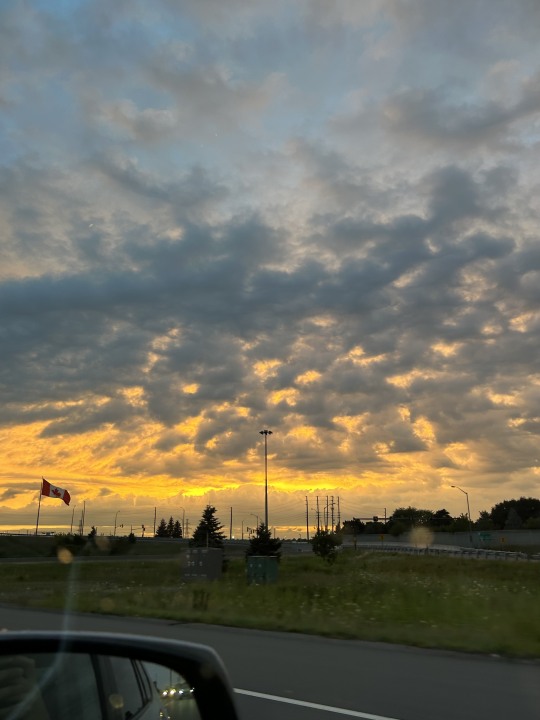
In this photo are some cirrus and cirrocumulus clouds. These clouds are located high in the sky and are detached from others or in sheets and are made predominantly of ice crystals, giving them a white colour.
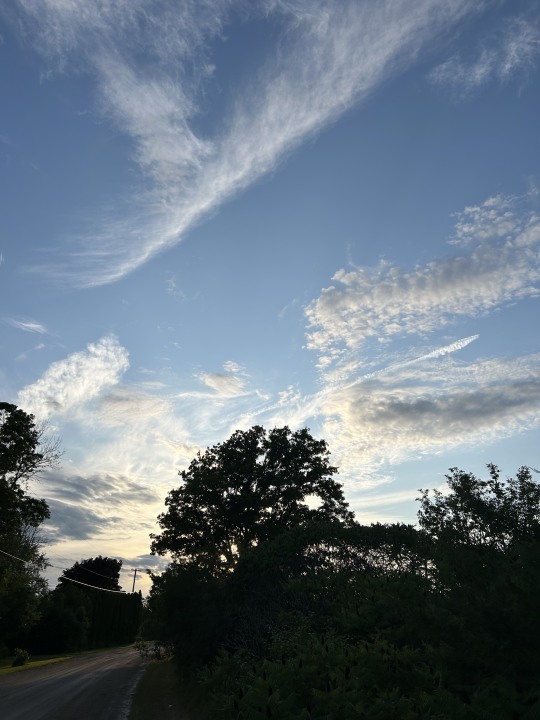
In this last one, we see a large impressive cloud called a cumulonimbus, this cloud spans all three sky heights and is the cloud that causes thunderstorms.

The changes in moisture in the environment change the properties of the clouds and not only does this have an impact on the weather, but I also found it had a large impact on people’s mood for the day. Even just waking up in the morning, I am almost instantly aware of how much sunlight is being let into my room. I always feel more energized when the sky is blue with some bright white clouds. This type of weather would always encourage more outdoor activities and opportunities to make memories.
Even if you are not focused on the clouds, you are still impacted by the atmosphere it creates. My fascination with clouds has stuck with me since this past summer, and I now find myself constantly looking up at the sky to appreciate them.
Means, T. (2020). The 10 Basic Types of Clouds. Retrieved from https://www.thoughtco.com/types-of-clouds-recognize-in-the-sky-4025569
1 note
·
View note
Text
happy holidays silly gay pple in my laptop, i thought yall deserved a lil christmas gift from jareth over here, so heres the best thing ive ever written-that-also-happens-to-be-anderperry-fanfiction
cobalt domes on stark white bulidings
Neil was in Santorini for a break. He just got himself an Oscar for his role as ‘King Oberon’ in the film adaptation of ‘A Midsummer Night’s Dream’. He was honestly pumped for the role, Oberon was in one of the first acting gigs he ever got for christ sakes! He wished he got to play Puck again; but he was deemed too old for the part even though he was only 25. (They casted a 15 year old as Puck, the kid was nice.) The role had most definitely stressed him to the brink of quitting. He loved acting, more than anything on this planet; But, he much preferred theater. Neil loved the, well, theater of it. Cinema just didn’t cut the high he felt on stage. Lights flashing in a way that made him feel on top of the world. He would much rather play The Faerie King Oberon on stage.
Santorini was a paradise for him. He first went when he was 18, it was for some movie he forgot the name of; he would never forget this island though. Cobalt domes on stark white buildings, red and black sand beaches lining the shores, magenta and blue sunsets dancing on the horizon, cerulean ocean entrapping the island in its comforting grasp, hugging the island in a watery blue embrace. Neil Perry was sure he’d never forget this place.
He rented a cave house, it was a lovely place to spend the summer. All white rooms with blue accents to match the cobalt domes. Neil was watching television by himself, when he had an idea. Neil cast his blue-ish mint colored button up to the side, and walked to his room, wondering if he should just buy a house like this, he had the cash, just needing to commit. The brunet would sell his soul to get away from everything and move to a place like this. He stripped off his taupe pants and put on his sea foam colored swim trunks. Walking across the hardwood floor to the deck pool, brushing a coffee colored bang out of his face and trying to fix his middle-parted hair back to how he liked it. His father always said he could never grow out his hair longer than his ears, he mainly just grew it out to defy him but ended up loving the style, thinking he looked quite ravishing with it.
Neil stepped into the infinity pool right on the deck of the cave house, swimming towards the edge of the pool. The Oscar winner watched the sunset, oranges waltzing with magentas and blues slow-danced in to replace them in order to cloud the sky in a black star filled blanket. Altocumulus clouds covering the summer sky in a haze. Neil simply rested his chin on the edge of the pool, arms resting under so his chin wasn’t lying on a hard surface. He really did love the island, Donkeys walking up and down the street, hooves clopping almost silent in the distance. That’s all he could think about, the only thing in his mind; Until he looked down. He saw a dirty blond boy writing poolside in baby blue swim trunks and an unbuttoned short sleeved sapphire button up. Neil couldn’t keep his eyes off of him.
‘Ok Perry, you’re not going to catcall this boy.’ Is what Neil told himself, if Charlie was here, he’d probably say something like: “Hey! This idiot wants to suck your cock!” at him, Charlie was anti-catcalling, but if it embarrassed Neil, he would surely do it. The blond boy must have felt Neil’s eyes on him, looking up from his writing and glaring at him with an equal mix of curiosity and worry. Ok Neil, now’s your chance.
“Hi? Why are you looking at m-me.” The other stuttered out in a sugar-sweet voice, looking up at Neil from his pool chair, a wash on his face like he was internally mapping out all the ways to book it. Neil perked up, sitting up so he looked more assertive, or something. “Just admiring the view. I knew this island was beautiful but I didn’t know it attracted people as gorgeous as itself.” The boy’s face flushed, then hid his embarrassment by looking at the deck.
“What brings you to Santorini?” Neil asked, putting his chin back on the ledge of the infinity pool, tilting his head in a curious way, feeling relaxed and comfortable by the other’s presence.
“Break from normal city life. New York City is like an exciting free trial of hell.” The boy admitted, looking up at Neil.
“Tell me about it. I’m here on the same reasoning.” Neil mentioned. he lived in Hollywood for about three months, but went crawling back to New York when he discovered how rubbish the Califorian city was for him.
“What are you writing?” Neil questioned, curious about this boy who held his fascination in his tender grasp, holding his heart tight, but gentle enough to not shatter it in his grip.
“Uh, poetry. I’m writing my next book.” The boy said, becoming more comfortable with Neil, adjusting in his chair to show his full attention was on the brunet.
“Me and my friends in school started a poetry cult in the woods of our boarding school.” Neil lightly laughed to himself. Todd was caught off guard and burst out laughing in a series of squawks. The dirty blond covered it up after he realized he just squawked in front of a stranger, he really only displayed his real laugh around his brother.
“Oh my god! How rude of me! I haven’t asked your name.” Neil realized. He needed a name to go to this face that had him entranced. Flurry of light freckles, blue eyes matching the color of the domes, perfectly toned. Not scrawny, but not jacked. This dirty blond boy looked like he was meant to be the patron god of this island.
“Todd Anderson.” Todd told him once he could stop laughing. Wait. Neil knew that name. How could he be so stupid! Todd was his favorite author. He knew the poet was spending the summer in Santorini, Neil got the news before even winning his Oscar!
“I love your work. I’m Neil Perry.” Neil stated, expression softing. He always wanted to meet Todd. Ask him about his creative drive and maybe even ask him out if he wasn’t the straight man the press had deemed him to be. Siting his poetry full of internal conflict as a boy wrapped up in a girl.
“Neil Perry? I love yours too. You really deserved that Oscar.” Ok, that made Neil blush Looking off to the plant on the deck to cover his vermillion flush. He knew he did a good job, but also thought the boy who played Puck deserved it much more than him. He saw himself in the boy, young and inexperienced, he just hoped the boy’s parents accepted their son and his career. “‘Green Carnations and Peacock Feathers’ is one of my favorite books.” The actor made him know. “Actually, do you wanna join me here?” Neil vaguely gestured to the pool he was in.
“I would love to.” Todd got up from the chair, the only thing really separating them was the wall of the infinity pool and stairs that Todd was now walking up. The dirty blond fumbled with the gate, asking Neil the code to enter. When he finally opened it, he took off the button up he was using as a cover-up and threw it on the ground. Neil's thoughts immediately thought of Todd discarding his shirt to the ground and taking him to bed to slot hips against hips from dusk to dawn.
Todd slipped into the turquoise pool with Neil. Todd sat next to in the pool, water lapping against both him and Neil’s bare chests. “Hi.” Todd stared at him. “I can’t believe I’m doing this.” Todd’s voice quivered a little. His hair almost glowing sliver in the moonlight, blue eyes looking like silvery water droplets. Neil pulled Todd in by the waist.
“If I make you uncomfortable, just stop me.” Neil looked in his eyes, iris colors clashing like the aquamarine waters against the black sand beach not too far away.
“I don’t want you to stop.” Todd practically demanded, shocked by how forward he sounded.
“Oh how direct Mr Anderson.” Neil teased, easing Todd in closer. The actor felt his hand drift up to the poet's face as natural as the water lapping against the two. Fingers resting on Todd’s jawline, slipping his thumb in between pink lips and feeling slightly crooked teeth under the pad of his digit, then pressing down his pink tongue. “You know, I think you’re brilliant.” Neil whispered, forehead almost resting on Todd’s, releasing his finger from the other’s mouth, now cupping his face. Something about Todd just made Neil want to get his hands on him, hold him in his arms as they breathed the same sea salt tinted air.
“You do? You barely know me.” Todd stated, Neil pulled his hand from his face and held
Todd’s neck. He never thought he would ever get to meet Neil, he even wrote a very small draft for a play he was writing, the main part written for him. He felt like he was a schoolboy again, with a crush on a rather famous actor that he happened to be in the arms of at this moment, water lapping against their bare chests.
“I know you’re a talented young man I am whipped for.” Todd drifted towards Neil, lips pressing on lips, chests pressing on chests. Neil’s tongue slipping into Todd’s mouth, moving himself to straddle the other. The blond's back pressed against the sky-facing wall of the infinity pool. “You couldn’t have forgotten your wallet in your pocket, would you?” Neil asked on Todd’s lips,
“Why would I have my wallet?” the other mumbled back, too immobilized by the sweet but heavy pleasure and endorphins coursing through his body. Todd responded by leaning into Neil, trying to get as close as possible. The brunet pulled away, teeth catching Todd’s lower lip but letting it go. Neil just gazed into his eyes, getting lost.
“Neil? Are you ok?” Todd asked, barely audible, not wanting to ruin the moment.
“Definitely, I just wanted to sight-see. Santorini is beautiful this time of year.” Neil leaned back down before the poet could respond, only this time to Todd’s neck. The actor began to suck at Todd’s neck, a slight salty taste from the saltwater pool; but Neil didn’t care, or really register it. Todd’s breath hitched as Neil migrated to his collarbones, leaving purple and red bruises on his skin.
“Neil…” Todd’s breathy voice trailed, frozen from the bliss. The actor's hips devilled into Todd’s, making him produce an almost ‘squeak’ sound, making Neil smile on his neck. Heat traveling from all the places Neil touched him gathering in his belt area.Neil pulled away. “I think-” “No, No. Come back.” Todd ushered him back, pecking on his lips. “Let me finish.” The author paused, gently placing his index finger on Todd’s lips in a shushing manner.
“I think we should get clean, then maybe we could go to bed,” Neil said, winking at the ‘bed’ part, looking down at Todd. Flushed, lips almost bruised by the kissing.
“Great idea” Todd agreed, a hot shower with Neil did sound pretty sweet. They got out of the pool, using Neil’s towel since Todd’s was by his previous chair. After they were at least more dry, they went to the bathroom. Neil turned on the shower, not even waiting for warm water, ushering himself and Todd in. After, getting into bed and making love all night long.
Todd woke up on his side, feeling arms around his waist and zero clothes on his body. “Yes.” Todd whispered to himself, feeling like he won. He thought he was dreaming honestly, brain piecing together random things from his memory and somehow making up some wet dream where he and Neil Perry, Oscar-winning heartthrob actor makeout in a pool and have coitus in the brunet’s house. Todd heard a sharp inhale next to him, and then Neil shuffled up to look at him.
“Todd? What was that?” Neil asked, looking down at him with a mix of bedhead and sex hair darting around his eyes.
“I thought I was dreaming about last night. I’m glad I wasn’t.” Neil turned him to lay on his back and flopped on top of him. “Me too.” The brunet smiled down at him, placing lips on lips once more. ‘Good Morning’ love making wasn’t something Todd expected to happen with him, honestly? Ever. Especially with Neil Perry. He was surprised he even had a male lover in our lord 1967!
“Neil, I’m not a one night stand. I want something.” Todd said in full seriousness after his ‘Good Morning’. Neil was already facing him, they didn’t know what to do with their hands so they decided just to hold the other’s. Neil’s face blushed vermillion with pupils dilated as wide as saucers.
“You’re assuming I didn’t want to commit, dumbnut.” Neil took his hands from his lover’s and placed his arms around Todd’s waist once more as to where they were earlier.
Neil and Todd were lovers and that is a fact. Coming home from their little vacations at the same time, Neil won (another) Tony for his role as ‘Robert Gastrell’ in the play Todd had written for him, kissing his then fiance when the camera panned to his face to capture his victorious reaction when his name was said. They bought one of the cave houses of the island and used it as their summer home. They would spend the rest of their lives together, on this island or New York City. Wherever it was, it was home.
#anderperry#anderperry fanfiction#dead poets society#dead poets#neil perry#todd anderson#author is a manwhore for santorini greece#neil x todd#todd x neil
8 notes
·
View notes
Text
summer of knowledge (day one)
im starting a little daily thing this summer called the summer of knowledge where i pick a topic at random and write notes and learn about it
i decided that i would post them here on tumblr bc i thought that other people might enjoy it IDK
anyways i was supposed to post this yesterday but i forgor (skull emoji)
june 1st was cloud types
clouds are made up of water droplets or ice crystals
there are three levels to clouds, high, mid-level, and low clouds.
high clouds (16,500-45,000 feet)
cirrus
feathery clouds that are made of mostly ice crystals
the wispy shape is from wind currents that twist and spread the ice crystals into strands
cirrostratus
thin, white clouds that cover the sky. usually seen in the winter
meaning: rain or snow soon
cirrocumulus
thin, patchy, sheet-like clouds. sometimes look grainy or full of ripples
meaning: good weather but cold, but if you live in the tropics this could be a sign of an approaching hurricane
mid-level clouds (6,500-23,000 feet)
altocumulus
several patchy white or gray layers. many rows of fluffy ripples
made of liquid water but dont usually produce rain
meaning: weather is fair
altostratus
gray or blue-gray clouds made up of ice crystals and water droplets. usually covers the entire sky
meaning: continuous rain or snow
nimbostratus
dark, gray clouds that seem to fade into falling rain or snow
very thick and blocks out any sunlight
meaning: gloomy with continuous rain or snow
low clouds (less than 6,500 feet)
cumulus
fluffy, white clouds
what most people think of when they think of clouds
weather: fair
stratus
thin, white sheets covering the whole sky
very thin so they dont produce much rain or snow
weather: fair but gloomy
cumulonimbus
what people think of when they think of a storm cloud
grow on hot days when warm, wet air rises very high into the sky
weather: possibility for rain, hail, or tornadoes
stratocumulus
patchy gray or white clouds that sometimes have a honeycomb like appearence
weather: fair weather for now but a storm could be approaching
other special clouds
contrails
made by high flying jet planes
still technically clouds because they are made of water droplets condensed from the water vapor in the exhaust of the jet engines
can tell us about the layers of moisture in the sky
mammatus clouds
actually altocumulus, cirrus, cumulonimbus, or other types of clouds that have these pouch-like shapes hanging out of the bottom
the pouches are made when cold air in the cloud sinks down towards earth
weather: severe weather might be on its way
orographic clouds
get their shape from mountains or hills that force the air to move over or around them
can also be formed by seabreezes and often appear as lines where two air masses meet
weather: afternoon thunderstorms could be a possibility
lenticular clouds
shaped like lenses or almonds
they get their shape from hilly terrain or just the way air is rising over flat terrain
other facts
clouds are named based on their shape and how high they hover in the troposphere
The genera names are all formed from the same five latin terms — cirro, cumulo, strato, nimbo, alto — which are mixed and matched to create names like cumulonimbus, cirrostratus, cirrocumuus…. you get the idea. Learning what each of these Latin roots means is key to keeping your clouds straight:
Cumulo translates to “heaped.” Think puffy, piled, marshmellowy clouds.
Strato translates to “layered.” Clouds with strato in their name are often flat and form a wide layer across the sky.
Nimbo translates to “rain,” and is used for the two clouds that regularly produce rain.
Cirro translates to “curl.” These clouds are sometimes (but not always) curled and are found in the highest layer of the troposphere.
Alto translates to “high.” Confusingly, this doesn’t mean the clouds in the highest part of the atmosphere, just that the cloud is higher relative to others of its type.
there were images but i can't put them on here because that is simply too much work.
also here are the websites i used
https://www.zmescience.com/feature-post/natural-sciences/climate-and-weather/weather-and-atmosphere/types-of-clouds/
https://scijinks.gov/clouds/
https://scied.ucar.edu/learning-zone/clouds/cloud-types (this one has fun games)
https://blog.nature.org/2020/09/22/whats-that-cloud-your-guide-to-cloudspotting/
anyways. there is no way in hell i am remembering any of these cloud names but i actually really enjoyed this topic. ive always been fascinated by clouds so i thought it would be fun to learn about ! i think my favorite clouds are the mammatus clouds and, i didn't write about these, but the Kelvin-Helmholtz clouds (they look like waves they are super cool)
ok ignore any spelling errors, enjoy learning about clouds, love you, goodnight
2 notes
·
View notes
Text
Virtual Sketchbook Section 3
Describing Physical Qualities:
While viewing the Spring 2024 art exhibited at the Ringling Museum, Moonlight Landscape, ca. 1785 by Joseph Wright of Derby (1734-1797) caught my attention. It is an oil painting on canvas of British origin. The dimensions of the piece are 25 1/2 x 30 1/2 in. (64.8 x 77.5 cm). Although Moonlight has a relatively monotone and dark color palette, the shades, hues, and lighting give the painting its beautiful depth. It evokes feelings of wonder, fantasy, and fairy-like enchantment. Soft light dances across the water and brushes the translucent clouds above. Almost at the center of the piece there is a single shepherd and his packing mule crossing the eroding arched bridge. Beneath the eerie structure and weeping foliage there is another man that appears to be fishing. To the left of the water in the far back the artist includes a faint castle-like ruin. I am especially amused by the lamppost to the far right of the arched bridge. From far to near (back to front) Moonlight has serene mountains followed by a much rockier and grand mountain, next the castle structure, then the bridge covering the full moon, and finally the layer of trees being the closest to us. These layers and attention to detail are truly sublime. The objects are proportionate with the moon and bridge being the focal point. The water appears to be secondary and points like a vee. The quality of the work is a balanced landscape. From the edges to the center the painting gradually lightens. The far right top and bottom corners and left bottom corner being almost black. The top left corner being the lightest with the greatest amount of gray and cream cumulous and altocumulus clouds. While Moonlight is several hundred years old its paint and canvas condition are well intact and smooth.
This Part is All About You:
Moonlight Landscape, ca. 1785 evokes feelings of wonder, fantasy, and fairy-like enchantment. While the physical size of the frame is small compared to many of the other paintings it manages to encompass a vast and inclusive scene. I am in awe of the sheer depth and details. I feel at peace and adventurous gazing at the scene. Inviting me to explore the landscape along with the characters in the art.
Now Research:
Joseph Wright of Derby born September 3, 1734, was an English painter. Of the 18th century Wright was one of the most renowned artists. Wright had a special interest in unusual lighting as showcased by Moonlight Landscape, ca. 1785. He studied under Thomas Hudson and formed a friendship with Hudson. Based on my research and information learned you can establish and distinguish your work with an element seemingly standardized, for Wright this the use of unusual lighting. Wright’s work encompassed the spirit of the Industrial Revolution. I picked Wright’s painting because of the unique use of sharp and soft light, especially the moonlight.


Resources:
Barker, E. E. (2009). Joseph Wright of Derby’s Moonlight Landscape in Cologne. Wallraf-Richartz-Jahrbuch, 70, 175–194. http://www.jstor.org/stable/24667670
https://shibbolethsp.jstor.org/start?entityID=https%3A%2F%2Fidp.scf.edu%2Fopenathens&dest=https://www.jstor.org/stable/community.14723515&site=jstor
https://artuk.org/discover/artists/wright-of-derby-joseph-17341797
0 notes
Text
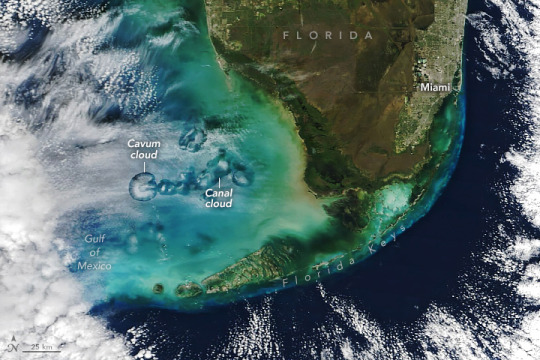
Making Sense of Holes in the Clouds
Cavum clouds, also called hole-punch clouds and fallstreak holes, look so odd that people sometimes argue they are signatures of flying saucers or other unidentified anomalous phenomena. Seen from below, they can look like a large circle or ellipse has been cut neatly from the clouds, with feathery wisps left in the middle of the hole.
They are equally impressive when seen from above. This image shows a cluster of cavum over the Gulf of Mexico off of Florida’s west coast on January 30, 2024. It was captured by the MODIS (Moderate Resolution Imaging Spectroradiometer) on NASA’s Terra satellite.
Otherworldly explanations are not required to explain the eye-catching cloud formation. While scientists have periodically mentioned the phenomena in scientific journals and speculated about their cause since the 1940s, a pair of studies published in 2010 and 2011, led by University Corporation for Atmospheric Research (UCAR) scientists, laid out an explanation that put other theories to rest. They are caused by airplanes moving through banks of altocumulus clouds.
These mid-level clouds are composed of liquid water droplets that are supercooled; that is, the droplets remain liquid even when temperatures are below the typical freezing point of water (32 degrees Fahrenheit, or 0 degrees Celsius). Supercooling happens when water droplets are exceptionally pure and lack small particles, such as dust, fungal spores, pollen, or bacteria, around which ice crystals typically form.
Supercooling may sound exotic, but it occurs routinely in Earth’s atmosphere. Altocumulus clouds, which cover about 8 percent of Earth’s surface at any given time, are mostly composed of liquid water droplets supercooled to a temperature of about -15°C.
But even supercooled clouds have their limits. As air moves around the wings and past the propellers of airplanes, a process known as adiabatic expansion cools the water by an additional 20°C or more and can push liquid water droplets to the point of freezing without the help of airborne particles. Ice crystals beget more ice crystals as the liquid droplets continue to freeze. The ice crystals eventually grow heavy enough that they begin to fall out of the sky, leaving a void in the cloud layer. The falling ice crystals are often visible in the center of the holes as wispy trails of precipitation that never reach the ground—features called virga.
Unlike previous attempts to explain the phenomena, the UCAR researchers, with colleagues from several other institutions, including NASA’s Langley Research Center, made use of a combination of aircraft flight data, satellite observations, and weather models to explain how the clouds form and to track how long they lasted. When planes passed through clouds at a fairly sharp angle, the researchers found that small, circular cavum appeared. If they passed through the clouds at a shallow angle, longer “canal clouds” with lengthy virga trails, like the one shown above, became visible.
Other factors that can affect the length of these clouds include the thickness of the cloud layer, the air temperature, and the degree of horizontal wind shear, the researchers reported. Their analysis showed that a full spectrum of aircraft types including large passenger jets, regional jets, private jets, military jets, and turboprops can produce cavum and canal clouds. With more than 1,000 flights arriving at Miami International Airport each day, there are many opportunities for planes to encounter the atmospheric conditions needed to produce cavum clouds.
NASA Earth Observatory image by Michala Garrison, using MODIS data from NASA EOSDIS LANCE and GIBS/Worldview. Story by Adam Voiland.
1 note
·
View note
Text
Yellow Sky Meaning: What Does a Yellow Sky Mean and Is It Bad If the Sky Is Yellow? - Impeccable Nest
Volcanic eruptions: Volcanic eruptions can also cause a yellow sky. When a volcano erupts, it releases sulfur dioxide gas, which can react with water vapor in the atmosphere to create sulfuric acid clouds. These clouds can reflect sunlight and create a yellow or orange tint to the sky. Sandstorms: In desert regions, sandstorms can occur and cause a yellow sky. As strong winds pick up sand and dust particles from the ground, they can create a thick cloud that covers the sky. This cloud can sometimes create a yellow or orange tint to the sky. Weather conditions: Certain weather conditions can also cause a yellow sky. For example, during a sunset or sunrise, the angle of the sun can create a golden or yellow glow in the sky. Additionally, certain cloud formations, such as altocumulus clouds, can create a yellowish hue in the sky. The Meaning of Dreams about Dogs: What Do They Signify? In conclusion, a yellow sky can be caused by various natural and - ubfbhrihp8

0 notes
Text
Hi! Good day everyone in m INA GRACE B. DECATORIA this is my BLOG.
@CLOUDS
All clouds are made up of basically the same thing: water droplets or ice crystals that float in the sky. But all clouds look a little bit different from one another, and sometimes these differences can help us predict a change in the weather.
Here’s a list of some of the most common cloud types you might spot in the sky:
High Clouds (16,500-45,000 feet)
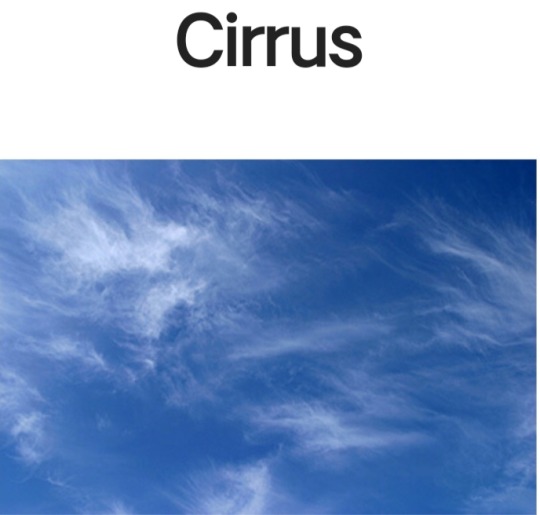
CIRRUS clouds are delicate, feathery clouds that are made mostly of ice crystals. Their wispy shape comes from wind currents which twist and spread the ice crystals into strands.

CIRROSTRATUS clouds are thin, white clouds that cover the whole sky like a veil. These clouds are most commonly seen in the winter, and can cause the appearance of a halo around the sun or the moon.

CIRROCUMULUS clouds are thin, sometimes patchy, sheet like clouds. They sometimes look like they're full of ripples or are made of small grains.
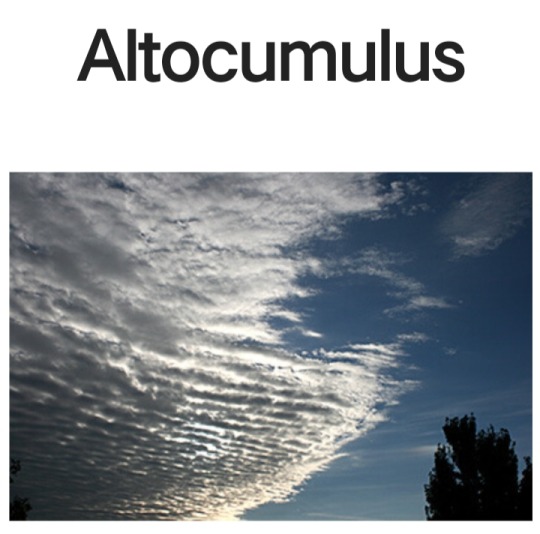
ALTOCUMULUS clouds have several patchy white or gray layers, and seem to be made up of many small rows of fluffy ripples. They are lower than cirrus clouds, but still quite high. They are made of liquid water, but they don't often produce rain.
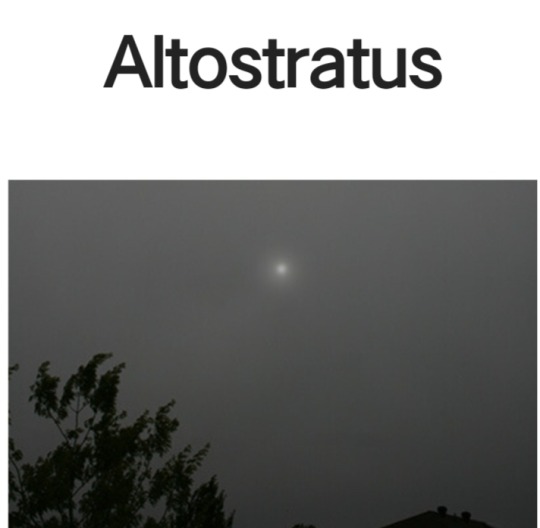
ALTOSTRATUS clouds are gray or blue-gray mid-level clouds composed of ice crystals and water droplets. The clouds usually cover the entire sky.

NIMBOSTRATUS clouds are dark, gray clouds that seem to fade into falling rain or snow. They are so thick that they often blot out the sunlight.
LOW CLOUDS (less than 6,500 feet)

CUMULUS clouds look like fluffy, white cotton balls in the sky. They are beautiful in sunsets, and their varying sizes and shapes can make them fun to observe.

STRATUS clouds often look like thin, white sheets covering the whole sky. Since they are so thin, they seldom produce much rain or snow. Sometimes, in the mountains or hills, these clouds appear to be fog.

CUMULONIMBUS clouds grow on hot days when warm, wet air rises very high into the sky. From far away, they look like huge mountains or towers.

STRATOCUMULUS clouds are patchy gray or white clouds that often have a dark honeycomb-like appearance.
In meteorology, a cloud is an aerosol consisting of a visible mass of miniature liquid droplets, frozen crystals, or other particles suspended in the atmosphere of a planetary body or similar space.[1] Water or various other chemicals may compose the droplets and crystals. On Earth, clouds are formed as a result of saturation of the air when it is cooled to its dew point, or when it gains sufficient moisture (usually in the form of water vapor) from an adjacent source to raise the dew point to the ambient temperature.
1 note
·
View note
Text
Cloud Classifications (Species & Varieties)
High-level clouds (5-13 km):
cirrocumulus, cirrus, and cirrostratus.

CIRRUS
Cirrus clouds are transparent or wispy curls or filaments of cloud floating high in the sky.
This type of cloud is always made of ice crystals whose degree of separation determines how transparent the cirrus is. Besides the filament appearance, cirrus clouds stand out among other types of cloud because they’re often colored in bright yellow or red before sunrise and after sunset, respectively.
Cirrus clouds generally occur in fair weather, but they can also hearld the leading edge of a far-away storm or may mark the edge of a storm passing to the north.
They commonly point in the direction of the air movement at their elevation.

CIRROCUMULUS
These usually form at about 5 km above the surface with small white fluff patterns that spread out for miles and miles over the sky. They’re sometimes called ‘mackerel skies’ because they can sometimes have a grayish color which makes the clouds look a bit like fish scales.
Cirrocumulus clouds exhibit features from both cumulus and cirrus clouds but should not be confused with altocumulus clouds. While the two can look similar, cirrocumulus does not have shading and some parts of altocumulus are darker than the rest. Cirrocumulus cloud comes after cirrus cloud during warm frontal system.
What’s worth keeping in mind about cirrocumulus clouds is that they never generate rainfall (but can mean cold weather) nor do they interact with other types of clouds to form larger cloud structures.
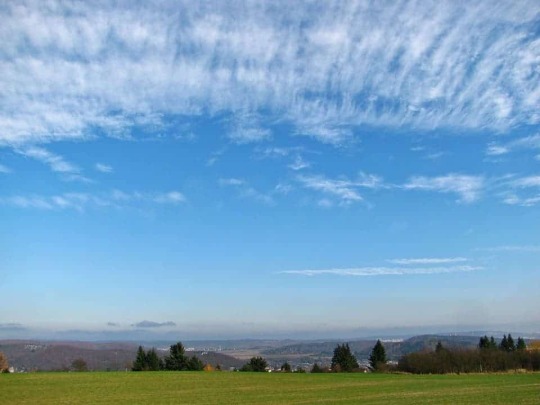
CIRROSTRATUS
Cirrostratus clouds have a sheet-like appearance that can look like a curly blanket covering the sky. They’re quite translucent which makes it easy for the sun or the moon to peer through. Their color varies from light gray to white and the fibrous bands can vary widely in thickness. Purely white cirrostratus clouds signify these have stored misture, indicating the presence of a warm frontal system.
Some of the best cloud pictures involve cirrostratus clouds because the ice crystals beautifully refract light from the sun or moon producing a dazzling halo effect. Cirrostratus clouds can turn into altostratus clouds if these descend to a lower altitude.
As a nice piece of trivia, cirrostratus clouds almost always move in a westerly direction. The sight of them usually means rainfall is imminent in the next 24 hours.
Mid-level clouds (2-7 km): altocumulus, altostratus, and nimbostratus.
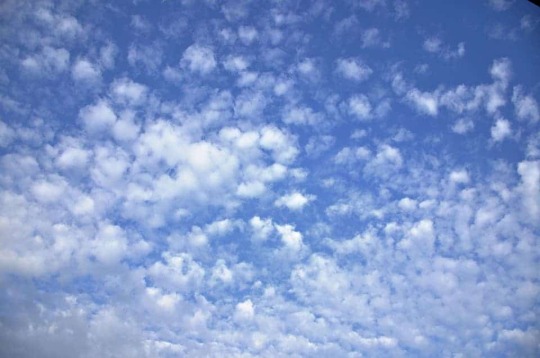
ALTOCUMULUS:
Altoculumus clouds are sometimes called ‘social clouds’ because they appear in groups. They have a grayish-white color with some portions darker than the others.��
Altocumulus clouds form at a lower altitude so they’re largely made of water droplets though they may retain ice crystals when forming higher up. They usually appear between lower stratus clouds and higher cirrus clouds, and normally precede altostratus when a warm frontal system is advancing. When altocumulus appears with another cloud type at the same time, storm normally follows. Altocumulus clouds are common in most parts of the world.
Altocumulus clouds are quite common in most parts of the globe. They usually grow by convection, in most cases after damp air rises to mix with descending dry air. Altocumulus clouds may also form in combination with other types of clouds like cumulonimbus. The amount of rainfall from altocumulus is projected from light to moderate.

ALTOSTRATUS
Altostratus often spread over thousands of square miles and are strongly linked to light rain or snow. Though they’re not capable of yielding heavy rain it’s common for altostratus clouds to morph into nimbostratus clouds which are packed with moisture and can deliver a pounding.
They’re uniformly gray, smooth, and mostly featureless which is why they’re sometimes called ‘boring clouds’. You’ll commonly see this types of clouds in an advancing warm frontal system, preceding nimbostratus clouds.
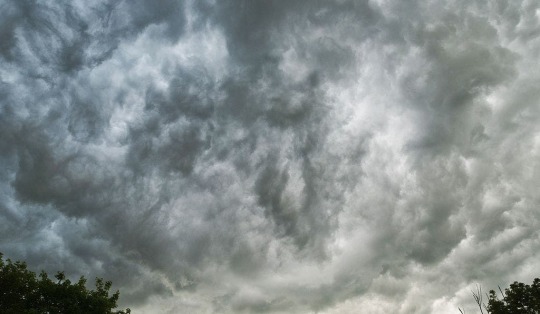
NIMBOSTRATUS:
The name Nimbostratus comes from the Latin words nimbus which means “rain” and stratus for “spread out”. These gloomy clouds are the heavy rain bearers out there forming thick and dark layers of clouds that can completely block out the sun. Though they belong to the middle-level category, they may sometimes descend to lower altitudes.
Nimbostratus clouds form as a result of the gradual accumulation of moist area over a large area as the warm frontal system lifts the warm and moist area higher up in the atmosphere where it condenses. As outlined earlier, a nimbostratus cloud can form from other types of clouds, like a descending altostratus. Spreading cumulonimbus clouds may also lead to the formation of nimbostratus.
When a stratus cloud (below) produces precipitation it is called a nimbostratus cloud. Dark, heavy nimbostratus clouds can drop steady rain for hours.
Low-level clouds (0-2 km):
stratus, cumulus, cumulonimbus, and stratocumulus.

STRATUS:
Stratus clouds are dull, flat, heavy horizontal clouds that lay low in the sky. They are commonly gray but can be white.
Stratus clouds often bring a drizzle or they can bring snow.
The altitude of stratus clouds indicate how fast a storm is approaching. Low stratus clouds usually mean rain will begin soon.
Stratus clouds appear as a hazy veil. They are featureless and depressing. Sometimes they are called “high fog.” They always obscure the sun.
The word “stratus” comes from the Latin prefix “strato-“, meaning “layer”.
Stratus clouds often linger for days as prolonged cloudy weather.

CUMULUS:
‘Cumulus’ is Latin for ‘heap’.
Cumulus clouds commonly indicate fair weather, though they may discharge rains sometimes in form of a light shower. Cumulus clouds are often seen on bright summer days.
Cumulus clouds are flat at the bottom and billowy above.
They are formed by a mass of unstable air, usually air warmed at the ground that is rising. As the warm air rises from the earth—often the air is rising from a patch of bare ground heated by the sun–it cools and the vapor in the rising air condenses into the visible cumulus cloud.
Think of each cumulus cloud as the top of a column of rising air.
The flat bottom of the cumulus cloud indicates the altitude at which the rising vapor has cooled to the point of condensation. Cumulus clouds commonly appear at 3,000 to 6,000 feet (914-1,828 m) but can form and rise higher.

CUMULONIMBUS
The cloud that produces showers and thunderstorms.
When cumulus congestus clouds produce rain they are called cumulonimbus clouds. Cumulonimbus clouds often form flat, anvil-like tops. These are known as thunderheads and usually bring rain, thunder, and lightning.
It’s a vertical developing type of cloud whose base grows from one to up to eight kilometers, hence it’s commonly called a tower cloud. For the same reason, cumulonimbus is both a low-level and high-level type of cloud. At the low-altitude base, the cloud is mostly made of water droplets but the high-altitude summit is dominated by ice crystals.
The rain comes and goes with this cloud but when it does, it can come pouring. When you see a cumulonimbus, you know there’s a thunderstorm waiting to happen somewhere.
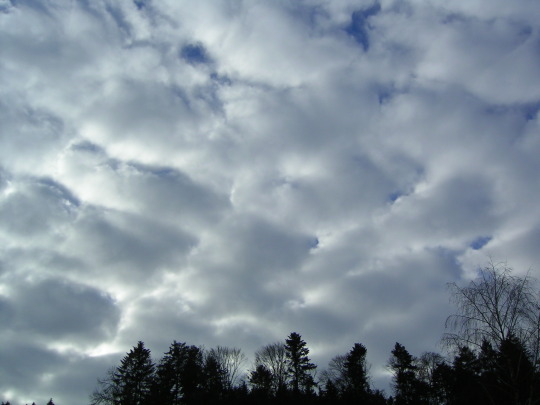
STRATOCUMULUS:
When an accumulation of warm air breaks through a higher mass of cool air it can billow up to form a stratocumulus cloud.
Stratocumulus clouds are low-lying clouds that have a wide horizontal structure.
Stratocumulus looks like a thick white blanket of stretched out cotton. They resemble cumulus clouds except they’re far bigger. The base is well-defined and flat but the upper part of the cloud is ragged due to convection with the cloud itself. Depending on the thickness of the cloud, a stratocumulus will have light to dark gray hues.
People often think rain is imminent when they see these clouds. In reality, you’ll be lucky to get a light drizzle out of them.
CLOUD SPECIES & VARIETIES
All of the above represents a broad classification as each type of cloud can be further grouped by species and varieties. The varieties are grouped and named based upon transparency and the arrangement of cloud elements, like so:
duplicatus (du) – more than one layer at different levels;
intortus (in) – irregular or tangled;
lacunosus (la) – thin cloud with regularly spaced holes, net-like;
nebulosus - A species of stratus or cirrostratus cloud with a murky, nebulous appearance
opacus (op) – completely masks sun or moon;
perlucidus (pe) – broad patches with some (small) gaps allowing blue sky to be seen;
radiatus (ra) – broad parallel bands convergind owing to perspective;
translucidus (tr) – translucent enough to permit the sun or moon to be seen;
undulatus (un) – sheets with parallel undulations;
vertebratus (ve) – looking like ribs or bones;
Cirrus species
Cirrus fibratus – The most common type of cirrus cloud. Thin and fibrous, cirrus fibratus is often aligned with the high altitude wind direction. It appears as white parallel stripes which streak across the sky.
Cirrus uncinus – Has a trademark hook shape.
Cirrus spissatus – Thick and dense, cirrus spissatus tends to dominate the sky above.
Cirrus floccus – These have a more cotton wool like appearance than any other cirrus.
Cirrus castellanus – More vertically developed and have a turret-like summit.
Cirrocumulus species
Cirrocumulus stratiformis – These are the famous ‘fish scale’ clouds.
Cirrocumulus lenticularis – Often larger than other clouds in the family with a rounded shape.
Cirrocumulus floccus – Have a more ragged appearance than other species. The species often appears in smaller patches with other cirrocumulus clouds.
Cirrocumulus castellanus – Taller than they are wide, these cute clouds resemble tiny towers in the sky
Cirrostratus species
Cirrostratus fibratus – It looks a lot like cirrus only with more consistency. It has the look of an animal’s fur.
Cirrostratus nebulosus – Has the appearance of a veil covering the sky. It’s featureless and sometimes unnoticeable.
Altocumulus species:
Altocumulus stratiformis – Looks like a bunch of flat-bottomed puffy clouds packed tightly together but separated by small streaks.These can sometimes extend over the whole sky.
Altocumulus lenticularis – Lens-shaped clouds that usually form over hilly areas. These are often called spaceship clouds since they often resemble a UFO.
Altocumulus castellanus – These often lead to cumulonimbus thunderstorms. They’re taller and more puffy looking than they are wide.
Altocumulus floccus – Often spotted alongside altocumulus castellanus, altocumulus floccus is made of more rugged cloudlets.
Altostratus species: When stratus clouds form higher than 7,000 feet, they are called altostratus clouds.
Altostratus Undulatus – Characterized by thin layers that resemble waves. These are a sign of slight mid-atmospheric instability.
Altostratus Duplicates – In this cloud formation, you will see two or more layers of altostratus clouds on top of each other.
Altostratus Pannus – Has chaotic layers that make it look like a shredded cloth.
Altostratus Translucidus – It’s more transparent than other species allowing the contour of the sun to be visible through it.
Altostratus Radiates – Clouds come in wide parallel bands pointing towards the horizon.
Altostratus Mamma – The name ‘mamma’ comes from the hanging pouches of this altostratus species which resemble a woman’s mammary glands.
Altostratus Opacus – Seen in wet days, this is a gloomy species which, once it descends, transforms into the rain-bearing nimbostratus.
Stratocumulus species
Stratocumulus stratiformis – This is the most common type of cloud out of all across the globe. Essentially, these are flat-based clouds with cracks in between.
Stratocumulus cumulogenitus – These interestingly form when a cumulus encounters a temperature inversion.
Stratocumulus castellanus – These are thicker, more drizzly stratocumulus clouds.
Stratocumulus lenticularis – The rarest variety of stratocumulus, these are often spotted in hilly locations which produce atmospheric waves. These clouds have a lens-like shape.
Stratus species
Stratus Fractus – Cloud filaments whose appearance changes rapidly due to wind gusts.
Stratus Nebulosus – Featureless gray stratus clouds that form in cool and stable conditions when moist air moves onto a water or cold ground surface.
Stratus Opacus – These are the clouds that completely or partly covers the sun or moon.
Stratus Undulatus – This variety displays a wave-like undulation.
Stratus Praecipitatio – A form of stratus cloud that comes with precipitation through ice prisms, snow grains or light drizzles.
Stratus Translucidus – Has a veil-like pattern that outlines the sun and moon.
Cumulus species
Cumulus humilis – These cumulus clouds are wider than they are tall. You’ll often find more than one dotting the skyline.
Cumulus mediocris – As the name implies, these clouds are just as wide as they are tall. You’ll usually see them amongst a variety of other cumulus species.
Cumulus congestus – These taller than they are wide resembling long chimneys. Cumulus congestus clouds can extend upward to as high as 39,000 feet (12,000 m). When cumulus congestus clouds produce rain they are called cumulonimbus clouds.
Cumulus fractus – Simply the broken remnants of cumulus clouds that are dissipating.
Cumulonimbus species
Cumulonimbus calvus – The top looks like a cumulus because the tower has not produced ice crystals yet.
Cumulonimbus capillatus – The top-side of the tower cloud is fibrous. This time, the water droplets have started to freeze, indicating rainfall is to be expected.
Cumulonimbus incus – Like in the case of cumulonimbus capillatus, the top of the cloud is fibrous but this time also anvil-shaped. This characteristic shape is the result of the cloud reaching the barrier of the troposphere and must now grow outward.
via: [1.] [2.] [3.] [4.]
See also: whatsthiscloud.com
#clouds#cloud spotting#cloud identification#cloud classification#science#cloud science#classifications#cumulus#cirrus#stratus#weather
1 note
·
View note
Photo

What are Clouds?
Many people believe clouds are made of water vapour (a gas). However, this is not strictly true. Water vapour is invisible, and it is always around us in the air. Sometimes more water vapour is in the air, and it feels humid or muggy. Other times, the air has less water vapour and feels drier and fresher.
Clouds appear when there is too much water vapour for the air to hold. The water vapour (gas) then condenses to form tiny water droplets (liquid), and it is the water that makes the cloud visible. These droplets are so tiny that they stay suspended in the air.

Tender Leaf Weather Watch Weather Watch - Kid's Weather Station - Educational Weather Board (zanypig.co.uk)
How are clouds formed?
As a simple explanation, when air rises, it cools, much like when you are going up a mountain, and the air tends to get colder. Cold air can't hold as much water vapour as warm air can, so as the air cools, it becomes saturated, and the water vapour in it condenses. This means it turns from a gas to a liquid, much like when you get condensation on a cold window. When the water vapour turns to a liquid in the sky, it forms lots of tiny little water droplets which cling to little bits of dust; this group of little water droplets suspended in the air becomes visible as the cloud we see.
These droplets of water are only about a hundredth of a millimetre in diameter, but the cloud is made up of an extensive collection of these. If the cloud is high enough in the sky and the air is cold enough, the cloud is made of lots of tiny ice crystals and gives a thin, wispy appearance.
There is also the fact that a cloud can form when more water vapour has been added to the air; for example, if it has passed over a lake, it can pick up moisture. Then, more water vapour in that air condenses to form the cloud.
You're bound to notice that clouds vary in shape, height and depth. The names given to the various cloud types are all derived from Latin words, of which the five most important are:

Clouds are classified into ten basic types. All their names combine the five Latin words that have just been mentioned.
High Clouds above 20,000 feet
Cirrus (Ci) detached clouds of delicate and fibrous hair like or silky appearance without shading.
Cirrostratus (Cs) Transparent whitish veil which does not blur the sun's or moon's outlines. Sometimes a fibrous sheet, and sometimes gives the sky a milky look. Sun will still cast shadows on objects on the ground.
Cirrocumulus (Cc) A thin layer or patch of cloud is composed of tiny elements in the form of grains or ripples like those in the sand on the seashore. Again, no shading.
Medium Clouds, between 6,500 and 20,000 feet
Altocumulus (Ac) A layer or patch usually comprises flattened, rounded masses or rolls. Some shading in larger masses.
Altostratus (As) A uniform fibrous veil usually greyish or bluish in colour, like Cirrostratus, but thicker. Varies in thickness and colour. No shadows of ground objects.
Low Clouds below 6,500 feet and arranged in groups, lines or waves which may or may not be touching one another. Appears soft and grey with darker parts.
Nimbostratus (Ns) A featureless layer of cloud thick enough to blot out the sun, from which rain or snow falls. Usually, dark grey. Low-ragged clouds frequently occur below the layer with which they may or may not merge.
Stratocumulus (Sc) A layer or patches of rounded masses or rolls, the elements being relatively large, usually larger than Altocumulus and arranged in groups, lines or waves which may or may not be touching one another. Appears soft and grey with darker parts.
Stratus (St) A uniform, featureless layer of cloud, resembling fog but not entirely resting on the ground, although it frequently covers hills. Usually light grey.
Come rain, come shine

Kid's Umbrella's - Magic Colour Changing Umbrellas - Kid's Brollies (zanypig.co.uk)
Heap Clouds, base usually below 6,500 feet, but the top may be well over 20,000 feet.
Cumulus (Cu) thick clouds with vertical development. The upper part of the cloud is rounded, like a cauliflower, while the base is flat. Clear spaces in between clouds. May show strong contrasts of light and shade, the sunlit parts being brilliant white and the grounds relatively dark. Vary greatly in size, from small 'cotton wool' like lumps to large masses, but the top of the cloud is always rounded.
Cumulonimbus (Cb) heavy mass of cloud with significant vertical development, whose cumuliform summits rise in the form of anvils or towers, which have a fibrous texture. This cloud is the only one to give marked showers, hail or thunder, so if you see any of these, you know the cloud is Cumulonimbus.

#clouds#weather#learning#rainyday#sunnyday#winter#spring#summer#autumm#kids#kids toys#maketimetoplay
0 notes
Video
Time lapse of a thunderstorm captured from an aircraft from 12,000m (40,000ft) shows a towering cumulus convection that rises from an altocumulus cloud cover.
0 notes
Text
Identifying the 10 Basic Cloud Types
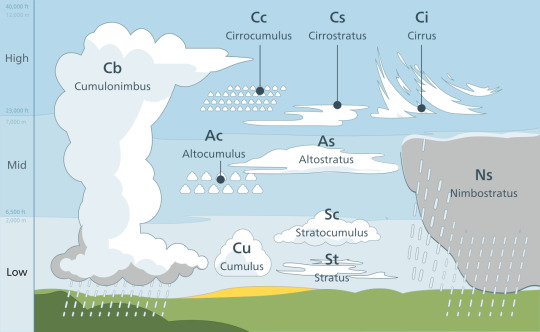
While there are hundreds of possible cloud descriptions, most clouds fall into 10 basic types, determined by the level of our atmosphere in which they appear:
low-level clouds (cumulus, stratus, stratocumulus) below 6500 feet
middle clouds (altocumuls, nimbostratus, altostratus) 6500-20000 feet
high-level clouds (cirrus, cirrocumulus, cirrostratus) above 20000 feet
and the Cumlonimbus which can stretch all three.
The 10 basic types of clouds are:
Cumulus - The typical cloud shape drawn. White and fluffy tops with a flat, dark underside. Appear on clear, sunny days. Nicknamed "fair weather" clouds.
Stratus - Flat, featureless, uniform layer resembling fog. Overcast days, often with light mist or drizzle.
Stratocumulus - Patchy, puffy clouds that almost look like honeycomb. General cloudy days
Altocumulus - Looks like sheep wool, dotting the sky in white or grey patchy round masses, sometimes aligned in parallel bands. Mistaken for stratocumulus. Altocumulus is smaller and higher up. Warm humid days, can signal thunderstorms and can appear ahead of cold fronts.
Nimbostratus - Dark, thick, grey layer of cloud that can blot out the sun. THE rain cloud.
Altostratus - Grey or blueish-grey sheets of cloud, but still partially transparent.
Cirrus - Latin for "curl of hair." Thin white whispy strands. Appear in fair weather, but also before large scale storms and tropical cyclones.
Cirrocumulus - Small white patches of clouds in rows at high altitude, called "cloudlets." Usually in winter, in fair but cold weather.
Cirrostratus - Transparent, whiteish clouds covering the sky in a veil. Can produce a halo effect around the sun or moon. Moisture in the upper atmosphere ahead of a warm front.
Cumulonimbus - Spans all three layer of the atmosphere. Bottom resembles cumulus but towers above like a cauliflower plume. Thunderstorm clouds, also heavy but short rainfall or hail. Possibly tornadoes.
"Mares' tails (cirrus) and mackeral scales (altocumulus) make lofty ships to carry low sails."
-sailor's proverb warning of incoming rainy weather
☁️
Nephelai
The Nephelai are Okeanid nymphs of clouds and rain depicted as young, beautiful women pouring water from pitchers or flitting across the sky with billowing robes
They are the daughters of Okeanos, the river that encircles the earth, and sister to the Potamoi, river gods, whose streams they feed with their earth nourishing rain.
🏺 Devotional act to Zeus and the nephelai 🏺
Sources:
Clouds image
Cloud descriptions
Additional reading:
Weather.gov
ZME Science
Wikipedia
201 notes
·
View notes
Text
Forecasting the Weather 2: Clouds
Hello lighthouse keepers, sailors, fishermen, and even pirates! I recently made a post about predicting the weather while at sea. I mentioned in the post that clouds can also help predict the weather, but didn’t include them for brevity, but I did say I’d make that post another day. Well, today is that day! Consider this your guide for using clouds to anticipate the storms before they happen. (Pictures correlate with the word above them)
Fair Weather Clouds
Cirrus (see-ruhs) clouds are thin and wispy due to the wind blowing them around the sky. They look like this:

Cirrocumulus (see-ruh-kyoo-myuh-luhs) clouds are thin, patchy, and generally rippled or poofy. They generally come out in the winter. They look like this:

Altocumulus (al-tow-kyoo-myuh-luhs) clouds are rippled, fluffy and layered, the layers ranging from white to greyish. They look like this:

Cumulus (kyoo-myuh-luhs) clouds are what you think of when you think of clouds. They’re big, puffy, and come in lots of different shapes.

Stratus (stra-tus) clouds are thin and sheet-like, and always white and will generally cover most if not all of the sky.
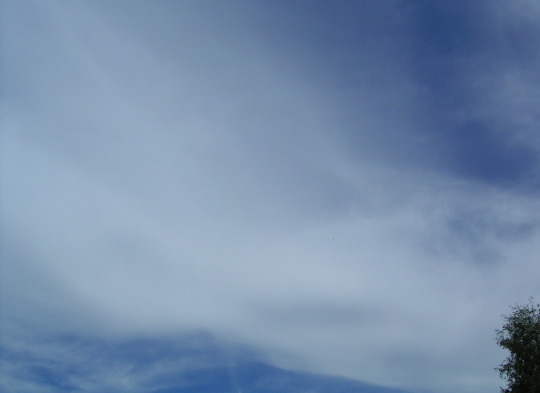
Stratocumulus (stra-tow-kyoo-myuh-luhs) congregate in honeycomb-esque shapes, and they are patchy white or gray in color. Though these are fair weather clouds, they can indicate a storm is on its way.

Rain Clouds
Cirrostratus (see-row-stra-tuhs, sur-row-stra-tuhs) clouds also cover the sky, and can cause the halo-ing effect that was mentioned in part 1 of this post. Rain is probable within the next day.

Altostratus (al-tow-stra-tuhs) clouds are grey, cover the sky, and mean continuous rain.

Nimbostratus (nim-bow-stra-tuhs) clouds are big, puffy, gray, and thick. They’re often so thick they can obscure the sun. These also indicate continuous rain.

Cumulonimbus (Kyoo-myu-low-nim-bus) clouds are high, towered, puffy and white. They indicate upcoming thunderstorms and are generally accompanied by other cumulus clouds.
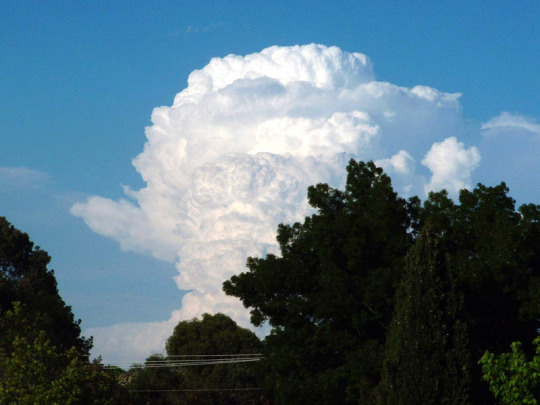
Sorry for such a long post but the pictures were necessary! Hope this second part is a good supplement to part one! Have fun keeping your eyes on the skys!
#lighthousecore#piratecore#sailorcore#fishermancore#seafarercore#nauticalcore#lighthouse aesthetic#pirate aesthetic#sailors log#fisherman aesthetic#seafarer aesthetic#nautical aesthetic#mine#guides
3K notes
·
View notes
Photo




March 3 2021
Today the sky was low with nimbostratus clouds and it drizzled off and on. In the morning, an adult male rufous/Allen’s hummingbird flitted through the rain and perched near a feeder, darting his head back and forth as he kept watch. He would keep returning to the same spot throughout the day.
As the morning progressed the rain intensified, falling steady and straight. Still, small flocks of songbirds bobbed and leapt across the sky, off to some drier place.
By the afternoon, the rain had stopped, although the sky remained impenetrably grey until nightfall.
Walking around the yard I noticed some patches of moss growing in a small ditch in the wet, clayey earth. In the flash of my camera the miniature leaves glistened and their form was revealed, tiny spiky spirals all clustered together.
We have a pair of mourning doves nesting in an alcove and I spent some time watching one huddled over its eggs that chilly evening as night approached. I noticed its body rise and fall almost imperceptibly with each quick breath. It seemed to sleep, but maybe it was still aware of my presence in the fading light, watching me with its left eye.
The sky cleared somewhat by nightfall, scattered altocumulus clouds that half-obscured the stars. The cover of darkness brought smaller creatures out from their hiding places, even in the cold. Cutworm caterpillars, pill bugs, and smooth slugs all slowly crept across the ground. An adult ring-legged earwig was busy scavenging the husk of another insect, this one winged like a lacewing, but eventually scurried off, searching for more.
At the end of the night, I brought inside two honeybees I found on the ground to protect them from the cold. With the warmth, one was able to revive itself and it began buzzing frantically around the little container I had put it in, so I released it. The other, sadly, didn’t make it. I remember holding it in my hand as I watched its striped abdomen pulse with its quick heartbeat, a tiny miracle of nature. Even though it didn’t last long, I think that moment will stay with me for a long time.
#nature#writing#rain#birds#hummingbird#moss#plants#clouds#photography#nature photography#wildlife photography#nature notes#original#mine
3 notes
·
View notes
Text
Nephelomancy

or Nephomancy - Divination by Clouds
Telling the past, determining the present, and foretelling the future by reading the clouds. Shape, Color, Direction, Formation, and Location all go into a cloud reading.
First, let's learn a little bit about the history of Nephelomancy.
For ages, mankind has looked to something bigger than themselves for guidance. Beings they could not see, but only dream of. Aside from the Sun, the Moon, and the Stars; the clouds are another heavenly entity which seem to send messages. Dark, thick, angry clouds... white, fluffy, happy clouds.. free and fanciful wisps.. They flow and grow as though controlled by a higher being.
Early civilizations would pray, pour libations, and hold various kinds of sacrifices in hopes of calming or pleasing whatever gods may be watching over them. They would do this for rain to quench the fields, to keep meteorological disasters from happening, or for some kind of sign for guidance.
Closely related and a more broad term, Aeromancy (divination through atmospheric conditions), was first mentioned as a form of science, rather than as divination. It was mentioned in Deuteronomy 18 as being condemned by Moses. Albertus Manus also condemned it, as he believed it was related to necromancy. It was also one of the seven "Forbidden Arts" in Renaissance times (along with geomancy, hydromancy, necromancy, osteomancy, palmistry, and pyromancy.)
In the Greek commedy "The Clouds" by Aristophanes, Socrates declares to Strepsiades the clouds as the only true deities, that only they should be paid homage to. In this play, the clouds would change shape to reveal the true nature of those gazing upon them.
Next, we'll learn about the forms of clouds.
We have a lot to thank modern meteorology for, in understanding and classifying the varying shapes and forms of clouds. Here, however, we'll go over the ten basic types of clouds, as there are more than 100 classifications.. but they fit pretty neatly into ten basic types, which can be categorized by the various altitudes in which they lie.
Low-Level Clouds (below 6,500ft) - Cumulus, Stratus, Stratocumulus
Middle Clouds (between 6,500 and 20,000ft) - Altocumulus, Nimbostratus, Altostratus
High-Level Clouds (above 20,000ft) - Cirrus, Cirrocumulus, Cirrostratus
Cumulonimbus clouds go across all altitude levels.
Cumulus clouds are flat and a little dark on the bottom, with light puffy tops. You see these from late morning to early evening when the day is clear and the sun warms the ground.
Stratus clouds are gray, hazy, and a uniform layer (think of fog, but in the sky.) You'll see these on overcast days, usually accompanied with a light rain.
Stratocumulus clouds are a nice mix of their namesake. They occur in big, honeycomb style patches on mostly cloudy days.
Altocumulus clouds are similar to Stratocumulus, but are higher altitude, smaller, and more round. You see these on warm, humid, summer mornings (signaling rain later in the day,) or ahead of cold fronts.
Nimbostratus clouds are -the- rain cloud. They're dark, thick, and extend from the lower to mid-level altitudes. You see these when it is going to, or when it is raining or snowing.
Altostratus clouds are gray, or bluish-gray hazy clouds which mostly cover the mid-levels. You can still see the sun through them, but there are no shadows. You'll see these ahead of any weather front coming through.
Cirrus clouds are light, wispy, curls of white, and made of ice crystals (high-altitude, cold, water vapor.. favorable for forming ice.) These occur on nice, fair-weather days, or ahead of warm front and large-scale storms. A sailor's provers states "Mares’ tails (cirrus) and mackerel scales (altocumulus) make lofty ships to carry low sails."
Cirrocumulus clouds are similar to altocumulus, but much smaller, organized into rows, made of ice crystals, and found at a much higher altitude. They're rare, have a short life, but can be seen on cold, fair weather days.
Cirrostratus clouds are nearly transparent and cover or veil almost the whole sky. A dead giveaway to identifying them would be when you see a halo around the sun. These are seen on warmer days when there is either a lot of moisture in the atmosphere, or ahead of a warm front.
Cumulonimbus clouds are huge. These storm-producing clouds grow from cumulus and stretch across all altitudes. The tops of these clouds often flatten and plume out like an anvil.
Finally, let's learn the how.
Divining with clouds is truly more involved with intuition. It takes time and also requires more of an open mind. It's better when you're not out looking for specific shapes. It can either tell you more about yourself, or generalize occurances coming to you.
Some shapes to consider --
Angels or Felines - listen to your intuition.
Buildings - symbolize how you see yourself. Bigger buildings are confident, smaller buildings, not so much.
Crocodiles or Snakes - danger or deceit.
Circles - feeling complete or marriage ahead.
Deer, Moose, Reindeer - be more assertive. Take control.
There is by no means a definitive list of shapes. It truly is personal to you and your own history and beliefs. Signs that are personal to you. For example, a small bird shape could represent one person's family member watching over them, while to another, it means innocence or wishful thinking.
Back to the 10 Basic Shapes, they could symbolize the following..
Cumulus - naivety, childishness, innocence, joy
Stratus - secrets, hidden motives, a snake in the grass
Stratocumulus - strength, courage, wisdom, protection
Altocumulus - comfort, a safety blanket
Nimbostratus - power, abundance, influence
Altostratus - stability, prosperity, cohesiveness
Cirrus - freedom, adventure, loose ties, vacation
Cirrocumulus - dreams, sowing seeds for the future, intuition
Cirrostratus - beginnings, renewal, inner calling
Cumulonimbus - turmoil, growing pains, change, difficult times
The Direction in which the clouds move can have meaning. Associate these with the characteristics of the elements we associate with each cardinal direction.
North - Air - Adaptability, Emotions, Charm, Fluidity, Creativity
East - Earth - Force, Inspiration, Trust, Love, Sincerity
South - Fire - Energy, Growth, Strength, Health, Loyalty
West - Water - Fertility, Solidity, Energy, Persistence, Confidence
How quickly or dramatically a shape forms and disappears can affect the meaning, such as something resolving or happening sooner or later. If a cloud splits, or example, it could mean more than one possible outcome. Alternatively, if shapes combine, cross paths, or are closer/farther apart, they can impact each other's meanings. The cloud's location in the atmosphere can be relative to the likelyhood of something happening (closer, lower altitude, more likely... farther, higher altitude, less likely.)
Keep in mind that meanings can alter, pending context, personal feelings and intuition.
image credit riverwindphotography.tumblr.com
114 notes
·
View notes
